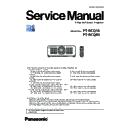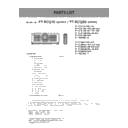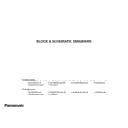Panasonic PT-RCQ10 / PT-RCQ80 (serv.man3) Service Manual ▷ View online
2
PREFACE
< RCQ10 / RCQ80 >
CAUTION
About lead free solder (PbF)
This projector is using the P.C.Board which applies lead free solder.
Use lead free solder in servicing from the standpoint of antipollution for the global environment.
Notes:
• Lead free solder: Sn-Ag-Cu (tin, silver and copper) has a higher melting point (approx. 217°C) than standard solder Typically the melting point is 30~40
°C higher. When servicing, use a high temperature soldering iron with temperature limitation function and set it to 370 ± 10 °C.
• Be precautious about lead free solder. Sn-Ag-Cu (tin, silver and copper) will tend to splash when heated too high (approx. 600°C or higher).
• Use lead free solder for the P.C.Board (specified on it as “PbF”) which uses lead free solder. (When you unavoidably use lead solder, use lead solder
after removing lead free solder. Or be sure to heat the lead free solder until it melts completely, before applying lead solder.)
• After solder to double layered P.C Boards, check the component side for excess solder which may flow onto the opposite side.
About the identification of the lead free solder P.C.Board.
For the P.C.Board which applies lead free solder, the symbol as shown in the figure below is printed or stamped on the surface or the back of P.C.Board.
PbF
Notice on laser
This projector is the Class 3R laser product that complies with IEC 60825-1:2007.
The class 4 laser module is mounted in the inside of a product.
The service technician is required to read and follow the “Safety Precautions” and “Important Safety Notice” in this service manual.
Le technicien d'entretien doit lire et suivre les «Précautions de sécurité» et «Avis important de sécurité» dans ce manuel d'entretien.
WARNING : Use laser Light Radiation eye and skin protection during servicing
AVERTISSEMENT : Utilisez laser lumière oeil radioprotection et la protection de la peau lors de l'entretien
7
WARNING
This service information is designed for experienced repair technicians only and is not designed for use by the general public.
It does not contain warnings or cautions to advise non-technical individuals of potential dangers in attempting to service a product.
Products powered by electricity should be serviced or repaired only by experienced professional technicians. Any attempt to ser-
vice or repair the product or products dealt with in this service information by anyone else could result in serious injury or death.
7
AVERTISSEMENT
Ce document d'entretien est destiné aux techniciens d'entretien expérimentés uniquement et n'est pas conçu pour une utilisation par le
grand public. Il ne contient pas des avertissements ou des mises en garde pour aviser les non-techniciens des dangers potentiels lorsqu'ils
tentent de réparer un produit. Les appareils alimentés par l'électricité doivent être révisés ou réparés uniquement par des techniciens pro-
fessionnels expérimentés. Toute tentative d'entretenir ou de réparer le ou les produits traités dans ce document d'entretien par autrui peut
entraîner des blessures graves ou la mort.
CAUTION / MISE EN GARDE
Lithium Battery
Risk of explosion if battery is replaced by an incorrect type,
Replace only with the same of equivalent type recommended by the manufacturer.
Dispose of used batteries according to the manufacturer’s instructions.
Batterie au lithium
Risque d'explosion si la batterie est remplacée par un type incorrect,
Remplacez-la uniquement par le même type ou le type équivalent recommandé par le fabricant.
Jetez les batteries usagées conformément aux instructions du fabricant.
DPQT1024YA
For North America
“Complies with 21 CFR Parts 1040.10 and 1040.11
except for deviations pursuant to Laser Notice
No.50 dated June 24.2007”
IEC 60825-1:2007
No.50 dated June 24.2007”
IEC 60825-1:2007
LASER RADIATION
AVOID DIRECT EYE EXPOSURE
CLASS 3R LASER PRODUCT
WAVE LENGTH:448-462nm
MAXIMUM OUTPUT:248mW
PULSE DURATION:1.1ms
IEC 60825-1:2007
RAYONNEMENT LASER
EXPOSITION DIRECTE DANGEREUSE POUR LES YEUX
APPAREIL À LASER DE CLASSE 3R
LONGUEURS D'ONDES:448-462nm
MAXIMALE DU RAYONNEMENT:248mW
DUR
DUR
ÉE DE L'IMPULSION:1.1ms
130C
チチƷチチᬼယყଙڻǾոᄃყଙǺ᭩ڻǾ℉ȡᇷ⯶ǤǪǹǓǢǷ
DPQT1025ZA
ュモワヨユンノヤロモヴヴチフチロモヴユンチンモュリモヵリヰワチヸラユワチヰヱユワチモヷヰリュチユヺユチヰン
チチチチチチチチチチチチチチチチチチチヴレリワチユヹヱヰヴヶンユチヵヰチュリンユヤヵチヰンチヴヤモヵヵユンユュチンモュリモヵリヰワ
ュモワヨユンノンモヺヰワワユヮユワヵチロモヴユンチュユチヤロモヴヴユチフチノチユワチヤモヴチュトヰヶヷユンヵヶンユチ
ュモワヨユンノンモヺヰワワユヮユワヵチロモヴユンチュユチヤロモヴヴユチフチノチユワチヤモヴチュトヰヶヷユンヵヶンユチ
チチチチチチチチチチチチチチチチチチユヹヱヰヴリヵリヰワチュモワヨユンユヶヴユチモヶチンモヺヰワワユヮユワヵチュリンユヤヵチヰヶチ
チチチチチチチチチチチチチチチチチチュリョョヶヴチュユヴチヺユヶヹチヰヶチュユチロモチヱユモヶ
DPQT1332ZA
THIS PROJECTOR MAY BECOME RG3 FOR PROFESSIONAL USE
ONLY AND IS NOT INTENDED FOR CONSUMER USE WHEN AN
INTERCHANGEABLE PROJECTION LENS IS USED UNDER THE
CONDITION THAT THROW RATIO IS GREATER THAN 2.2.
REFER TO THE OPERATING INSTRUCTIONS OR LEAFLET
FOR HAZARD DISTANCE BEFORE OPERATION.
CE PROJECTEUR PEUT DEVENIR RG3 POUR UNE UTILISATION
CE PROJECTEUR PEUT DEVENIR RG3 POUR UNE UTILISATION
PROJECTION INTERCHANGEABLE EST UTILISÉ À CONDITION QUE
LE RAPPORT DE PROJECTION SOIT SUPÉRIEUR À 2,2.
PRENEZ CONNAISSANCE DE LA DISTANCE DU RISQUE AVANT DE
DIESER PROJEKTOR KANN ALS RG3 NUR FÜR DIE PROFESSIONELLE
VERWENDUNG EINGESTUFT WERDEN UND IST NICHT FÜR DIE
VERWENDUNG DURCH VERBRAUCHER KONZIPIERT, WENN EIN
AUSTAUSCHPROJEKTIONSOBJEKTIV VERWENDET WIRD, UNTER
DER VORAUSSETZUNG, DASS DAS PROJEKTIONSVERHÄLTNIS
ÜBER 2,2 LIEGT.
BEACHTEN SIE VOR DER BEDIENUNG DIE BEDIENUNGSANLEITUNG
UND DAS FALTBLATT IN BEZUG AUF DEN GEFÄHRDUNGSABSTAND.
ДАННЫЙ ПРОЕКТОР МОЖЕТ ВХОДИТЬ В ГРУППУ РИСКА RG3 —
ТОЛЬКО ДЛЯ ПРОФЕССИОНАЛЬНОГО ИСПОЛЬЗОВАНИЯ, И ОН
НЕ ПРЕДНАЗНАЧЕН ДЛЯ ИСПОЛЬЗОВАНИЯ ПОТРЕБИТЕЛЯМИ
ПРИ ИСПОЛЬЗОВАНИИ СМЕННЫХ ПРОЕКЦИОННЫХ
ОБЪЕКТИВОВ ПРИ УСЛОВИИ, ЧТО ПРОЕКЦИОННОЕ
ОТНОШЕНИЕ (THROW RATIO) БОЛЬШЕ ЧЕМ 2,2.
ПЕРЕД НАЧАЛОМ РАБОТЫ ОБРАТИТЕСЬ К ИНСТРУКЦИЯМ ПО
ЭКСПЛУАТАЦИИ ИЛИ БРОШЮРЕ, ЧТОБЫ УЗНАТЬ ПРО
ОПАСНОЕ РАССТОЯНИЕ.
이
이
프로젝터는 투사 비율이 2.2보다 큰 교체식 투사 렌즈를 사용한 경우,
전문가
전용인 RG3 등급이 될 수 있으며, 일반 소비자용이 아닙니다.
작동하기
전에 위험 거리에 대해서는 사용 설명서 또는 안내책자를
참조하십시오
.
DPQT1347ZA
本投影機使用可換式投影鏡頭,且投射率大於2.2
時,屬於僅適合專業使用的RG3級產品,不能用作
消費類電子產品。
操作前請先參閱使用說明書了解危險距離。
THIS PROJECTOR MAY BECOME RG3 FOR PROFESSIONAL
USE ONLY AND IS NOT INTENDED FOR CONSUMER USE
WHEN AN INTERCHANGEABLE PROJECTION LENS IS
USED UNDER THE CONDITION THAT THROW RATIO IS
GREATER THAN 2.2.
REFER TO THE OPERATING INSTRUCTIONS OR LEAFLET
FOR HAZARD DISTANCE BEFORE OPERATION.
3
PREFACE
< RCQ10 / RCQ80 >
There are special components used in this equipment which are important for safety. These parts are marked by 7 in the schematic
diagram, circuit board diagrams, exploded views and replacement parts list. It is essential that these critical parts should be replaced
with manufacturer’s specified parts to prevent shock, fire, or other hazards. Do not modify the original design without permission of
manufacturer.
IMPORTANT SAFETY NOTICE
Caution:
This equipment has been tested and found to comply with the limits for a Class A digital device, pursuant to part 15 of the FCC Rules.
These limits are designed to provide reasonable protection against harmful interference when the equipment is operated in a commer-
cial environment. This equipment generates, uses, and can radiate radio frequency energy and, if not installed and used in accordance
with the instruction manual, may cause harmful interference to radio communications. Operation of this equipment in a residential area
is likely to cause harmful interference in which case the user will be required to correct the interference at his own expense.
FCC Warning:
To assure continued compliance, follow the attached installation instructions. This includes using the provided power cord and shield-
ed interface cables when connecting to computer or peripheral devices. Also, any unauthorized changes or modifications to this equip-
ment could void the user’s authority to operate this device.
Notes on other repair services
f
When repairing a blown fuse, do not turn on the power after replacing only the fuse because it may cause a secondary
disaster such as smoke or fire. Turn on the power after confirming the cause of failure (structure, circuit, etc.) and taking
countermeasures.
f
After the repair service is complete, check that the product operates properly.
f
User setting information remains inside the product, so handle with care.
Intended use of the product
f
The purpose of the projector is to project a video signal from imaging equipment or a computer on a screen or other surface
as a still image or moving image.
Cautions when transporting
f
When transporting the projector, move the lens position to the home position and attach the lens protection material.
If lens sold separatelymodel, move the lens position to the home position, remove the projection lens, and attach the lens
hole cover.
f
Steps to move the lens position to the home position.
1) Press the <DEFAULT> button on the remote control while the lens shift adjustment screen is displayed.
2) Press q w to select [OK], and press the <ENTER> button.
f
Transport the projector with two or more people. Failure to do so may drop the projector, which may result in damage or
deformation of the projector, or injury.
f
Hold the bottom of the projector and do not hold the projection lens or the opening around the projection lens when trans-
porting. Failure to do so may cause damage. Also, handle the projector in a way not to apply excessive vibration or shock.
Failure to do so may cause a failure due to the damaged internal components.
f
Do not transport the projector with the adjustable feet extended. Doing so may damage the adjustable feet.
Lens hole cover
Lens protection material
4
PREFACE
< RCQ10 / RCQ80 >
Cautions when installing
r
After attaching the projection lens, be sure to attach the Lens Mount Cover.
Not doing so may cause failure due to accumulating dust internally.
r
r
Do not set up the projector outdoors.
The projector is designed for indoor use only.
r
r
Do not set up the projector in the following locations.
f Places where vibration and impacts occur such as in a car or vehicle: Doing so may cause damage to internal compo-
nents or malfunction.
f Location close to sea or where corrosive gas may occur: The projector may fall due to corrosion. Also, failure to do so
may shorten the life of the components and result in malfunction.
f Near the exhaust of an air conditioner: Depending on the conditions of use, the screen may fluctuate in rare cases due to
the heated air from the exhaust vent or the hot or cooled air from the air conditioner. Make sure that the exhaust from the
projector or other equipment, or the air from the air conditioner does not blow toward the front of the projector.
f Places with sharp temperature fluctuations such as near lights (studio lamps): Doing so may shorten the life of the light
source, or result in deformation of the projector due to heat, which may cause malfunctions.
Follow the operating environment temperature of the projector.
f Near high-voltage power lines or near motors: Doing so may interfere with the operation of the projector.
f Places where there is high-power laser equipment: Directing a laser beam onto the projection lens surface causes dam-
age to the DLP chips.
r
The projector may not work properly due to strong radio wave from the broadcast station or the radio.
If there is any facility or equipment which outputs strong radio waves near the installation location, install the projector at
a location sufficiently far from the source of the radio waves. Or, wrap the LAN cable connected to the <DIGITAL LINK>
terminal using a piece of metal foil or a metal pipe which is grounded at both ends.
r
Focus adjustment
The high clarity projection lens is thermally affected by the light from the light source, making the focus unstable in the
period just after switching on the power. It is recommended to perform the focus adjustment after 30 minutes have elapsed
with the focus test pattern displayed.
r
Do not install the projector at an altitude of 4 200 m (13 780') or higher above sea level.
r
Do not use the projector in a location that the ambient temperature exceeds 45 °C (113 °F).
Using the projector in a location where the altitude is too high or the ambient temperature is too high may reduce the life of
the components or result in malfunctions.
Do not use the projector in a location where the ambient temperature exceeds 40 °C (104 °F) when the optional Wireless
Module (Model No.: AJ-WM50 Series) is attached to the projector.
r
Projection in all 360° direction is possible.
r
Cautions when setting up the projector.
f The projector can be used by installing its top placed on the floor. To prevent the top surface from getting scratched dur-
ing use, it is recommended to attach about a 20 mm (25/32") square buffer material (such as rubber cushion) on the four
corners of the top surface.
f Use the adjustable feet only for the floor standing installation and for adjusting the angle. Using them for other purposes
may damage the projector.
f When installing the projector with a method other than the floor installation using the adjustable feet, top placed on the
floor, or the ceiling installation with the Ceiling Mount Bracket, use the five screw holes for ceiling mount to fix the projec-
tor to the mount.
In such case, make sure that there is no clearance between the screw holes for ceiling mount on the projector bottom and
the setting surface by inserting spacers (metallic) between them.
f Use a torque screwdriver or Allen torque wrench to tighten the fixing screws to their specified tightening torques.
Do not use electric screwdrivers or impact screwdrivers.
(Screw diameter: M6, tapping depth inside the projector: 12 mm (15/32"), torque: 4 ± 0.5 N·m)
f Do not stack projectors on top of each other.
f Do not block the intake/exhaust vents of the projector.
f Prevent hot and cool air from the air conditioning system to blow directly to the intake/exhaust vents of the projector.
360°
360°
360°
360° vertically
360° horizontally
360° tilted
(combination of vertical and horizontal)
5
PREFACE
< RCQ10 / RCQ80 >
f Do not install the projector in a confined space.
When installing the projector in a confined space, provide air conditioning or ventilation separately. Exhaust heat may ac-
cumulate when the ventilation is not enough, triggering the protection circuit of the projector.
f Panasonic takes no responsibility for any damage to the product caused by an inappropriate choice of location for install-
ing the projector, even if the warranty period of the product has not expired.
Usable outlet
100 mm (3-15/16") or longer
500 mm (19-11/16") or longer
500 mm (19-11/16") or longer
500 mm (19-11/16") or longer
This projector supports AC 100 V to AC 240 V as the power supply. A grounded outlet supporting 15 A is required
with either voltage.
The shape of the usable outlet differs depending on the power supply. Following illustrations are examples.
The shape of the usable outlet differs depending on the power supply. Following illustrations are examples.
2P/3W 15 A 250 V
2P/3W 15 A 250 V
2P/3W 20 A 250 V
2P/3W 15 A 125 V
2P/3W 15 A 250 V
Attention
f
Use the supplied power cord and ground at the outlet.
f
Use the power cord matching the used power supply voltage and outlet shape.
Note
f
The supplied power cords vary depending on the country or region where you purchased the product.



